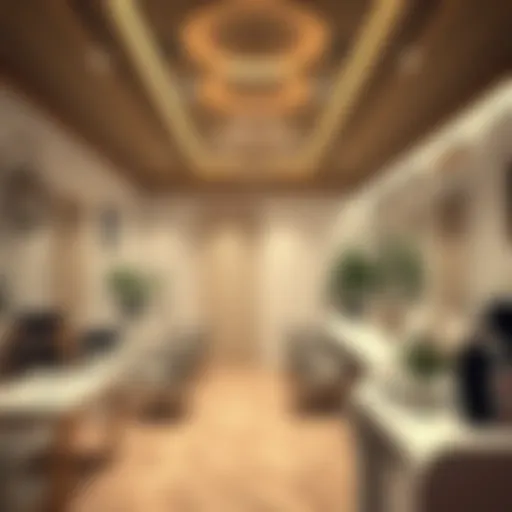Exploring One Za'abeel Tower: A Modern Marvel
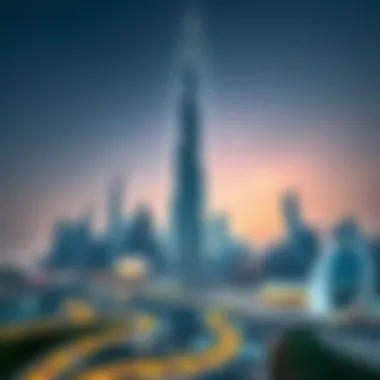

Intro
In a city known for its towering ambitions, One Za'abeel Tower emerges not only as a remarkable structure but also as a potent symbol of Dubai's relentless drive towards architectural mastery. This unique tower is redefining the skyline of Dubai, standing as one of the tallest buildings in the world and serving as a beacon of innovation and economic dynamism. Its cutting-edge design, featuring an intricate blend of aesthetics and functionality, exemplifies the spirit of modern urban architecture.
By examining the construction feats that made One Za'abeel a reality, we delve deep into the engineering marvels that lay behind its ambitious blueprint. From the unique grit of the materials used to the groundbreaking construction techniques employed, the tower showcases the heights that modern engineering can reach. But this exploration extends beyond mere structural analysis; it encapsulates the broader implications of this towering achievement on urban development, economic prospects, and cultural dialogues within Dubai.
As we traverse through the narrative of One Za'abeel Tower, you will uncover insights about its impact on local and international real estate trends. Whether you are a potential investor, a homebuyer, or a property manager, understanding the story of One Za'abeel can provide a clearer lens through which to view the ever-evolving landscape of Dubai's architectural offerings.
With this foundation laid, let us move into market insights, where we will assess the current dynamics shaping Dubai's real estate market.
Prologue to One Za'abeel Tower
One Za'abeel Tower is not just another high-rise; it symbolizes Dubai’s might in the realm of architecture and innovation. Located in the bustling heart of the city, this skyscraper is a beacon of modern ambition and a critical entry in the narrative of urban evolution in Dubai. As the city's skyline transformed over the years, One Za'abeel emerged as a focal point reflecting not only the architectural ingenuity unique to this region but also the economic and cultural aspirations of its populace.
Historical Context of the Project
The inception of One Za'abeel can be traced back to the early 2010s when Dubai was on the cusp of recovery from the global financial downturn. Reflecting a resurgence in confidence, the project sought to push boundaries—in both height and design. The vision was ambitious: to create an iconic tower that could stand as a testament to Dubai’s resilience and forward-thinking ethos.
In the context of Dubai’s architectural landscape, One Za'abeel was noteworthy as it would eventually claim the title of the world's tallest building, eclipsing the previous records set by its towering counterparts. Greater than a mere structure, its construction was indicative of a city determined to redefine itself and assert dominance on the global stage. The timing of this project coincided with several other high-profile developments, fostering a sense of competition that motivated architects and builders alike to dream bigger and think bolder.
Architectural Vision and Design
From a design perspective, One Za'abeel is nothing short of a marvel. Crafted by the prominent architecture firm, Zaha Hadid Architects, its design encapsulates the fluidity of modern movements with an emphasis on sustainability and resilience. The architects envisioned a building that integrates both aesthetics and functionality, allowing it to stand proud amidst the ever-changing cityscape.
The structure boasts an innovative design featuring a unique mix of glass and steel, which serves not only to catch the eye but also to enhance energy efficiency. This focus on ecological sustainability reflects a growing awareness within the architectural community regarding environmental responsibilities amidst the rush for urban development.
Moreover, the tower’s height was not simply a competition for records; it represented a strategic move to optimize space within Dubai’s densely populated urban core. Each floor is equipped with state-of-the-art facilities, meeting the demands of modern offices, luxury apartments, and commercial spaces, thus contributing to a multi-functional environment.
By merging cutting-edge technology with time-honored craftsmanship, One Za'abeel embodies a future-oriented mindset while still respecting the past and heritage of the region.
Thus, the architectural vision is clear: forge ahead while being mindful of sustainable practices and innovative techniques. The trajectory of One Za'abeel Tower is illustrative of Dubai's ambition, seamlessly blending tradition with the avant-garde, signifying a bright, aspirational future for urban living.
Architectural Specifications
The architectural specifications of One Za'abeel Tower are more than mere numbers and material choices; they function as a reflection of Dubai's obsession with pushing boundaries, literally and figuratively. The specifications detail not just the physicality of the structure, but also its functional design, sustainability measures, and a commitment to innovation that embodies the spirit of the city itself. In this section, we will explore the height and structure, the materials used in its construction, and the unique architectural features that make this tower an emblem of modern engineering.
Height and Structure
Standing tall at a staggering 1,000 meters upon completion, One Za'abeel Tower will become the tallest building in the world, eclipsing even the iconic Burj Khalifa. This remarkable height is not merely for show; it presents a statement, a challenge, and a vision of what can be achieved in vertical engineering.
The structure utilizes a core-and-outside framework that mixes reinforced concrete with steel, allowing it to withstand the high winds and seismic forces typical in skyscraper construction. The design itself has an innovative twist; the upper portion is a rotating element, making the tower not just high, but also visually dynamic. This aspect creates a unique aesthetic, making it a local landmark that captivates the eye from various angles throughout the city.
"A tower that twists into the sky, reshaping the skyline and visitors’ imaginations alike."
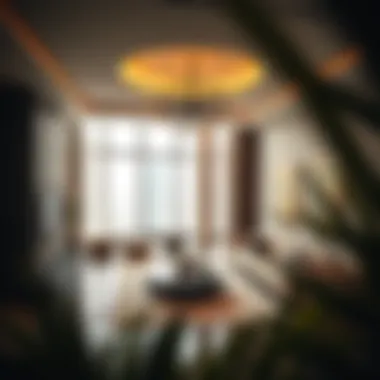
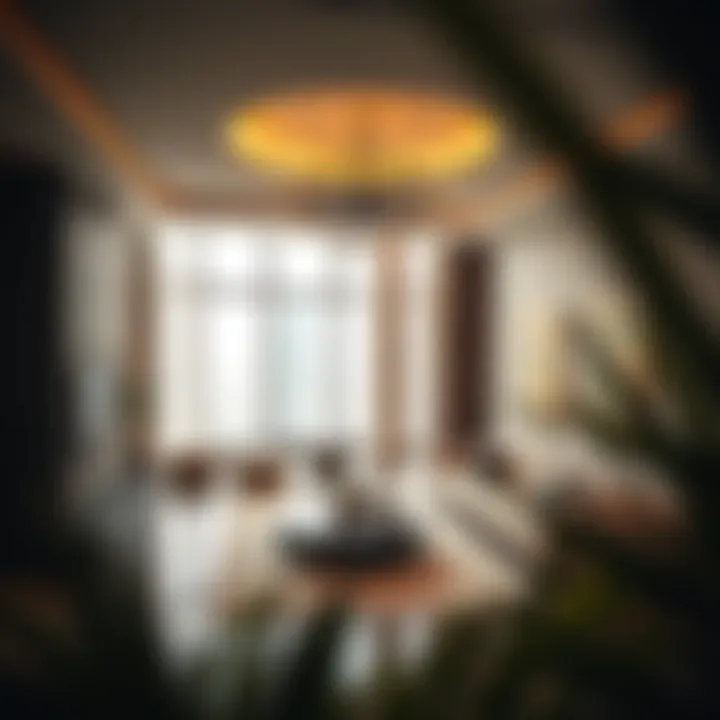
Materials Used
One Za'abeel's materials are selected with meticulous care, not only for their durability but also for their aesthetics. High-strength concrete, a material renowned for its resistance to erosion and ability to support massive loads, forms the backbone of the tower. This choice ensures that the structure can endure the test of time while maintaining its visual appeal.
Additionally, glass facades have been incorporated—using various coatings that help in controlling heat and light. This choice not only matters in terms of energy efficiency but also gives the building its sleek modern look. Other materials like aluminum and composite panels play a vital role, adding both elegance and performance.
Unique Architectural Features
What truly sets One Za'abeel apart is its unique architectural features. One of the standout aspects is its dual-purpose design, which includes not just office spaces but also a luxury hotel. This integration reflects a growing trend in architecture where functionality meets lifestyle convenience.
Moreover, the tower sports a distinct twisting silhouette that enhances its aerodynamic form. Large observation decks with panoramic views will offer a bird’s-eye perspective of Dubai’s sprawling urban landscape, while the sky garden provides a serene escape high above the bustling city.
In the context of Dubai’s architectural narrative, One Za'abeel Tower not only contributes to aesthetic diversity but also symbolizes ambition, creativity, and the relentless pursuit of excellence in design and engineering.
Engineering Innovations
Engineering innovations stand at the heart of One Za'abeel Tower, driving not just the construction but encompassing a broader vision for urban architecture in Dubai. The significance of such innovations paves the way for exploration of various technological advancements and methodologies, ultimately showcasing Dubai's ambition to remain at the forefront of architectural prowess.
Construction Challenges
Constructing One Za'abeel Tower came with its share of hurdles that tested the limits of engineering. The very height of the tower posed significant challenges in terms of structural integrity and stability. Building something that reaches 1,000 meters into the sky isn't a walk in the park. For instance, the engineering team had to devise specialized materials to withstand wind shear at such altitudes. Utilization of high-strength concrete was crucial here; its ability to provide high compressive strength while being lightweight made it a preferred choice.
Field conditions during construction were also an undeniable challenge. The extreme heat of the desert made scheduling tricky, affecting work hours and efficiency. Crew members had to adjust to a weather with temperatures often soaring above 40°C. To tackle this, the team deployed innovative cooling solutions and special insulated work zones to keep work progressing steadily without compromising crew safety.
Moreover, the intricate design that features the world's tallest occupied building presented issues in coordination amongst different trade teams. Ensuring clarity and precision required real-time communication channels and adaptive plans. Project managers relied on Building Information Modeling (BIM) as an effective planning tool, radically improving collaboration and problem-solving capabilities among various teams.
Sustainability Considerations
With all the engineering marvels, One Za'abeel Tower doesn't just focus on height—it strives for sustainability too. In recent years, there’s been a growing call for architects and builders to consider their environmental impact. The emergence of green building standards has influenced designs and material choices. The tower incorporates multiple sustainable practices which enhance its ecological footprint.
For instance, energy efficiency was a prime consideration. The installation of photovoltaic panels on the facades is a standout feature. These solar panels harness natural sunlight to provide a portion of the energy requirements for the tower. Subsequently, this not only reduces operational costs but also minimizes environmental impact.
Additionally, the effective use of water management systems in the tower, including rainwater harvesting, further exemplifies efforts toward environmental stewardship. According to project documentation, these systems can potentially reduce water consumption by a significant margin, contributing positively to overall sustainability goals.
Incorporating technology such as smart systems enhances the building's energy efficiency, allowing for real-time monitoring and adjustments according to usage patterns. This aligns with the global movement towards smart cities where technology and infrastructure combine seamlessly to improve living conditions and sustainability.
"By prioritizing both innovation and sustainability, One Za'abeel Tower showcases not only architectural ambition but a responsible approach to urban development."
Economic Impact on Dubai
The emergence of One Za'abeel Tower is not merely about its architectural splendor or engineering feats; it significantly shapes the economic landscape of Dubai. With its impressive height and unique design, the tower acts as a beacon, drawing both local and international investments. It’s like throwing a stone into a pond; the ripples extend far and wide, influencing numerous economic sectors beyond just real estate.
Investment Opportunities Created
One Za'abeel Tower opens the floodgates for a wave of investment opportunities. The structure itself, standing tall as one of the world’s tallest buildings, sets a precedent that beckons high-net-worth individuals and institutional investors alike. The allure of being associated with such a landmark leads to an influx of capital into the surrounding areas.
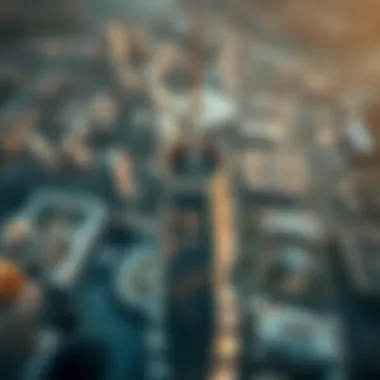
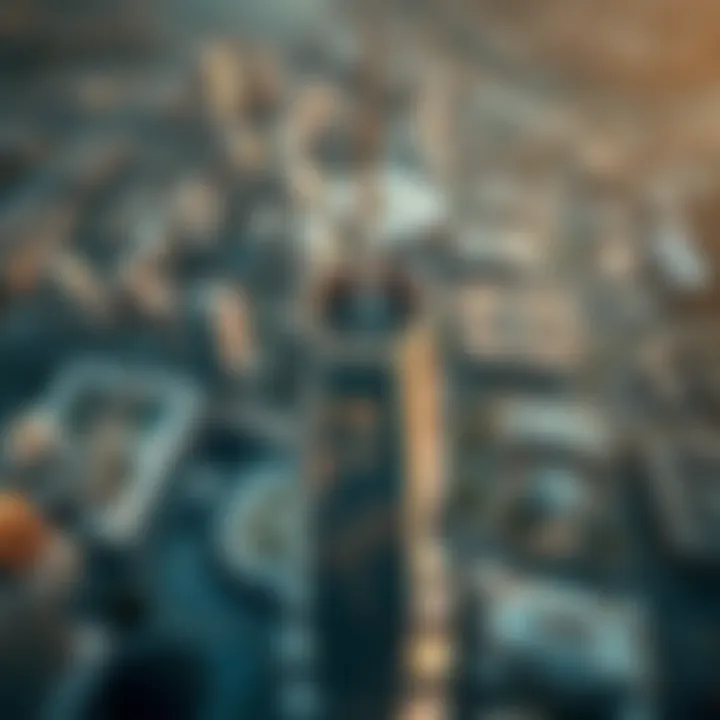
- Real Estate Development: Investors are keen to capitalize on the burgeoning demand for high-end residential and commercial spaces that will complement the tower. This surge in demand often spurs new developments, creating a ripple effect in the local real estate market.
- Job Creation: The construction and operational phases promise thousands of jobs, providing boosts to sectors that cater to both skilled and unskilled laborers. This is often a surefire way to improve the economic conditions of a city and uplift living standards.
- Financial Services Expansion: Due to its stature, One Za'abeel is likely to attract international firms seeking office spaces in a prestigious location. Consequently, financial service sectors will thrive, offering myriad career opportunities.
The logical endgame here isn’t just about profits; it’s about transforming Dubai into a global business hub, aided by strategic planning and investment influx resulting from the presence of the tower.
Tourism and Business Growth
In the world of skyscrapers, some simply reach for the sky, while others redefine horizons. One Za'abeel Tower falls into the latter category. The economic canvas of Dubai is richly painted with the brush of tourism, and this tower adds vivid strokes to that masterpiece.
As tourists flock to Dubai seeking unforgettable experiences, One Za'abeel will likely become a focal point. Imagine tourists gazing skyward, smartphones poised to capture the awe-inspiring design while learning about the architectural innovations that make it unique. It's a magnet, attracting not just curious travelers but entire business conventions.
- Increased Foot Traffic: With restaurants, boutiques, and cultural experiences linked directly to the tower, foot traffic is bound to increase, benefiting local businesses.
- Cultural Events: Hosting events like exhibitions or conferences in or around One Za'abeel could establish Dubai as a go-to destination for international conferences, heightening its stature on the global stage.
- Boosting Hospitality Sectors: Hospitality venues near the tower may see a surge in bookings, as tourists flock to enjoy not just the view from above but the luxury services that Dubai promises.
In essence, One Za'abeel Tower does more than just puncture the sky; it carves a new path for tourism and business growth, embedding itself deep into the economic framework of Dubai. This complex interdependency makes it clear that the tower is more than an aesthetic triumph; it is an economic powerhouse in its own right.
Cultural Significance
Understanding the cultural significance of One Za'abeel Tower extends beyond merely admiring its towering presence against Dubai's skyline. This architectural gem encapsulates the essence of a rapidly evolving cultural landscape, a symbol of how modernity intertwines with tradition in a bustling metropolis. The significance lies in multiple layers, affecting the city’s identity, community values, and even global perceptions of architectural ambition.
Symbol of Modernity
One Za'abeel Tower stands as a tall testament to modern engineering and architectural prowess. In a city known for pushing boundaries, this tower challenges conventional notions of skyscraper design. Its sleek lines and cutting-edge technology speak to an era where innovation governs urban development. The design, by the renowned firm Nikken Sekkei, reflects a harmonious blend of glass and steel, creating a striking silhouette that resonates with the forward-thinking spirit of Dubai.
The tower serves as a symbol of progress, not just in the physical sense, but also socio-economically. For investors and global business magnates alike, it mirrors the confidence placed in the region's future. The height of the tower, reaching in excess of 1,000 meters, signifies not only a literal ascent but also the elevation of Dubai's ambitions and capabilities on the world stage. Furthermore, it fosters a sense of pride among locals, embodying their aspirations in a rapidly modernizing environment.
Influence on Local Identity
The grandeur of One Za'abeel Tower contributes significantly to the evolving identity of Dubai. In a city that constantly redefines itself, the tower acts as a physical and cultural landmark. It's a place where tradition meets innovation, creating a narrative that residents and visitors can engage with. Locals regard the tower not just as an architectural feat, but also as a locus of community activities and gatherings, which enhances its role in the social fabric of the city.
To the residents, One Za'abeel represents a familiar space in an otherwise dynamic landscape. It has ushered in new kinds of social interaction, where workplaces and leisure spots coexist seamlessly. The tower has prompted an influx of businesses, enhancing Dubai's reputation as a global consultancy hub. Moreover, as a focal point in visual media and tourism, it transforms the perception of Dubai from a point on a map to a destination filled with meaning and emotion.
"One Za'abeel is more than just a building; it encapsulates the dreams and aspirations of a city reinventing itself amid the sands of time."
In sum, the cultural significance of One Za'abeel Tower goes far beyond its architectural marvel. It acts as a bridge between the rich traditions of the region and the relentless march toward modernization. For investors, homebuyers, and property managers, understanding this significance is essential, as it adds layers of meaning and value to the property landscape in Dubai.
Whether considering its role as a beacon of modernity or its deeper influences on local identity, One Za'abeel Tower stands unique in its contribution to Dubai’s evolving narrative.
Comparative Analysis
The significance of comparative analysis in the context of One Za'abeel Tower cannot be overstated. In a city renowned for its architectural ambition, understanding how this structure aligns with or stands apart from other global landmarks provides insight into both its uniqueness and its contextual relevance. Through comparison, one can grasp the architectural intentions behind One Za'abeel's design as well as the interplay between tradition and modernity that defines Dubai's skyline.
Against Other Global Landmarks
To appreciate the magnitude of One Za'abeel, it's essential to compare it with other iconic towers around the world. For instance, the Burj Khalifa, standing as the tallest structure globally, sets a high bar for any new competition. One Za'abeel aims to not only reach impressive heights but also push the boundaries of engineering. Here are a few points of comparison:
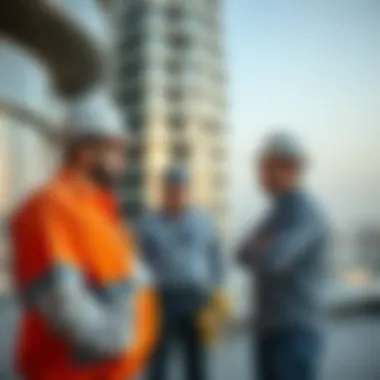
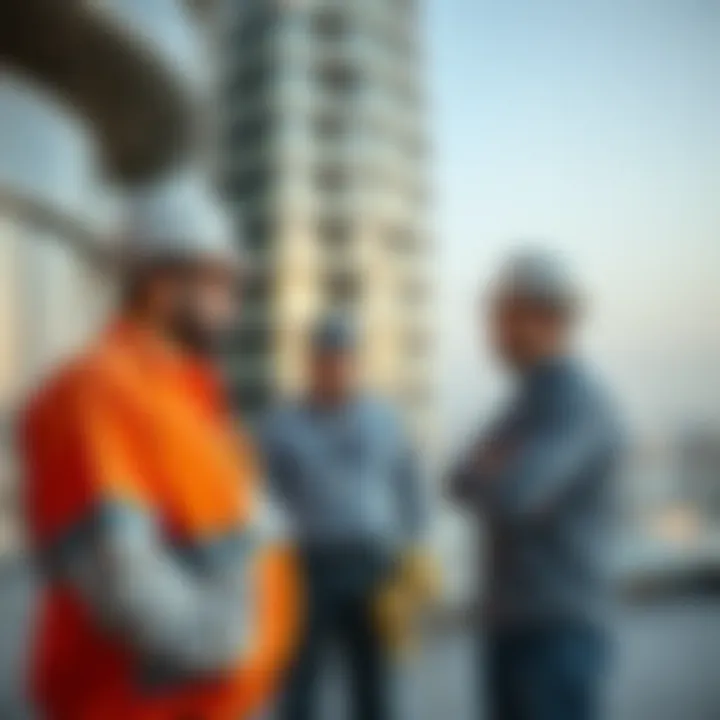
- Height: One Za'abeel is planned to reach a staggering height of over 1,000 meters, which places it firmly in the category of extreme skyscrapers. This is a bold statement against other notable structures like the Shanghai Tower or the Abraj Al Bait Clock Tower.
- Design Philosophy: Where the Burj Khalifa showcases a minimalist aesthetic characterized by its slender form, One Za'abeel embraces a more intricate design that integrates traditional Islamic architecture with contemporary materials.
- Purpose and Functionality: While many landmarks serve predominantly as tourist attractions, One Za'abeel combines commercial, residential, and hospitality spaces, promoting a dynamic environment for living and working.
"One Za'abeel Tower represents not just height, but a deeper narrative about ambition and cultural integration in urban development."
Through these comparisons, it’s clear that One Za'abeel Tower is not just another skyscraper; it’s an architectural statement that reflects Dubai's aspirations on the global stage.
Architectural Trends in Dubai
Dubai's architectural landscape is marked by a series of trends that balance extravagance with sustainability. As developers and architects look towards the future, One Za'abeel serves as an anchor point for these evolving trends. Here are a few key elements shaping current and future architecture in the emirate:
- Iconic Designs: Bold and unique shapes dominate the skyline, a hallmark of Dubai’s recent kradqeau of construction. From the twisting form of the Cactus Tower to the futuristic lines of the Museum of the Future, One Za'abeel continues this tradition of striking design.
- Sustainability: New skyscrapers are increasingly designed with green technology and sustainable materials, driven by a desire to create more environmentally friendly urban spaces. One Za'abeel incorporates elements aimed at reducing energy consumption, showcasing how luxury can coexist with responsible building practices.
- Mixed-Use Developments: As urban sprawl continues, the push for mixed-use towers grows stronger. One Za'abeel aligns with this shift, offering offices, hotels, and residential units in one location. This trend fulfills the need for multifunctional spaces that enhance urban living.
The architectural narrative in Dubai, especially through the lens of One Za'abeel, reflects a keen awareness of form, function, and future trends. The tower stands as a benchmark against which new developments will be measured, potentially guiding future architectural endeavors.
Future Implications
One Za'abeel Tower not only stands as an architectural marvel today but also serves as a harbinger of future developments in Dubai and beyond. The tower's significance extends to urban planning dynamics, economic growth, and its influence on architectural trends. Highlighting these future implications allows us to appreciate how this symbol of ambition could shape the environment and experiences of those who reside in and visit the city.
Urban Development in Dubai
Dubai has long been at the forefront of urban innovation, but One Za'abeel takes this a step further. The towering structure, which is poised to be one of the world’s tallest buildings, embodies the fusing of luxury with practicality. Its influence on urban development can be dissected into several key aspects:
- A Blueprint for Future Projects: The architectural techniques and materials used in One Za'abeel have paved the way for future constructions in the city. This tower will likely serve as a blueprints for not just high-rises, but for mixed-use developments that prioritize community spaces alongside residential and commercial utilities.
- Creating a Business Hub: The tower aims to become a commercial epicenter. As businesses flock to the area, it is expected to stimulate economic growth. This can attract foreign investments and promote the creation of jobs, enhancing Dubai’s status as an international business hub.
- Infrastructure Development: With a structure of this magnitude comes the necessity for improved infrastructure. One Za'abeel's establishment has triggered upgrades in surrounding roads, public transportation options, and utilities, thus ensuring that connectivity flows seamlessly throughout the people’s interactions with the tower.
"The development of One Za'abeel symbolizes more than just new heights; it redefines the urban landscape of Dubai."
Long-term Architectural Visions
As One Za'abeel takes its place in Dubai’s skyline, it also reflects long-term architectural aspirations. The tower symbolizes a shift toward a more meaningful approach to design. Each aspect of its construction and function gives insight into potential future trends:
- Integration of Sustainability: The focus on sustainable materials and energy efficiency in One Za'abeel’s design is likely to inspire future projects not just in Dubai, but globally. Architects are leaning increasingly toward eco-friendly practices, aiming to minimize their carbon footprints when erecting extravagant structures.
- Adaptive Use of Space: One Za'abeel features mixed-use spaces that combine residences, offices, and leisure activities within a single tower. This multifunctional approach resonates with evolving lifestyle preferences and urbanism philosophies, marking a departure from traditional zoning practices.
- Technological Upgrades: Future architectural endeavors may increasingly incorporate smart technologies for heat management, energy production, and user interaction within spaces. This integration not only enhances efficiency but also transforms how individuals engage with their environments.
In summary, One Za'abeel Tower is much more than an engineering masterpiece. It has become a core component of Dubai's urban narrative, laying down a framework that other cities can look to emulate. By examining these implications, we find there is more at stake than mere aesthetics; rather, they encompass a roadmap for the evolution of urban landscapes.
Finale
The completion of any significant architectural endeavor demands careful reflection on its impact and legacy, and One Za'abeel Tower is no exception. The tower is not just a structure; it's a symbol of Dubai’s architectural ambition, encapsulating the city’s aspiration to push boundaries. It’s essential, therefore, to take stock of the key elements that contribute to our understanding of this monumental achievement.
Summary of Key Insights
One Za'abeel Tower’s height and unique design serve as a powerful statement in Dubai’s skyline, showcasing a feat of engineering that reflects the city’s growth trajectory. Some key insights include:
- Height and Innovation: Standing at over 1,000 meters, it will be one of the tallest buildings in the world, representing more than just height; it symbolizes innovation.
- Economic Influence: The tower has opened up new avenues for investment and tourism, markedly enhancing Dubai’s status on the global stage.
- Cultural Resonance: It embodies modernity while respecting the traditional values, influencing the cultural landscape of the region.
These insights illustrate how One Za'abeel Tower is not merely a structure but a catalyst for economic growth and cultural identity in the heart of Dubai.
Final Thoughts on One Za'abeel's Legacy
The legacy of One Za'abeel Tower will unfold over the decades to come. As it becomes a landmark of international repute, its influence will likely inspire future architectural endeavors in the region and beyond.
- Sustainability Practices: Its incorporation of green technologies and sustainable practices sets a benchmark for future constructions.
- Urban Integration: The tower integrates well into Dubai’s urban fabric, preparing the ground for future developments that prioritize community and connectivity.
- Symbol of Aspiration: More than just an edifice, it stands as a testament to what can be achieved when vision meets execution.















